AMD A10-7800 Review: Testing the A10 65W Kaveri
by Ian Cutress on July 31, 2014 8:00 AM ESTCPU Benchmarks
The dynamics of CPU Turbo modes, both Intel and AMD, can cause concern during environments with a variable threaded workload. There is also an added issue of the motherboard remaining consistent, depending on how the motherboard manufacturer wants to add in their own boosting technologies over the ones that Intel would prefer they used. In order to remain consistent, we implement an OS-level unique high performance mode on all the CPUs we test which should override any motherboard manufacturer performance mode.
HandBrake v0.9.9: link
For HandBrake, we take two videos (a 2h20 640x266 DVD rip and a 10min double UHD 3840x4320 animation short) and convert them to x264 format in an MP4 container. Results are given in terms of the frames per second processed, and HandBrake uses as many threads as possible.
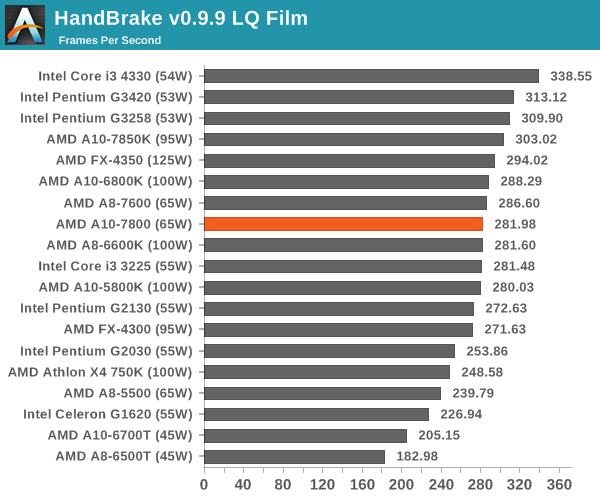
The latest Intel processors have the lead for low quality Handbrake conversion, and despite the generational gap between the FX-4350 and the A10-7800, the extra MHz is preferred here.

For large frame manipulation, the latest architectures mixed with the most threads perform best.
Agisoft Photoscan – 2D to 3D Image Manipulation: link
Agisoft Photoscan creates 3D models from 2D images, a process which is very computationally expensive. The algorithm is split into four distinct phases, and different phases of the model reconstruction require either fast memory, fast IPC, more cores, or even OpenCL compute devices to hand. Agisoft supplied us with a special version of the software to script the process, where we take 50 images of a stately home and convert it into a medium quality model. This benchmark typically takes around 15-20 minutes on a high end PC on the CPU alone, with GPUs reducing the time.
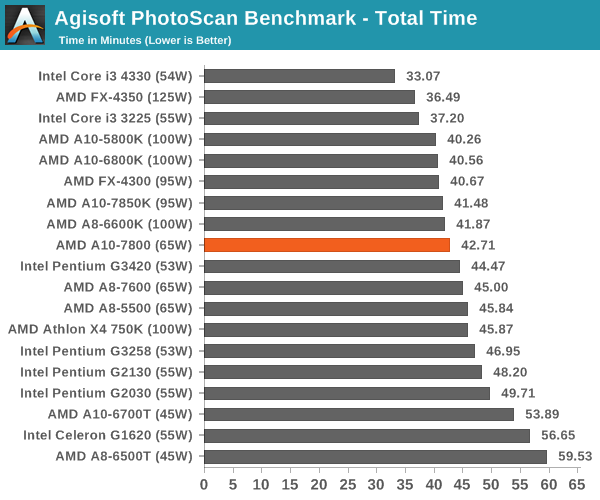
Dolphin Benchmark: link
Many emulators are often bound by single thread CPU performance, and general reports tended to suggest that Haswell provided a significant boost to emulator performance. This benchmark runs a Wii program that raytraces a complex 3D scene inside the Dolphin Wii emulator. Performance on this benchmark is a good proxy of the speed of Dolphin CPU emulation, which is an intensive single core task using most aspects of a CPU. Results are given in minutes, where the Wii itself scores 17.53 minutes.
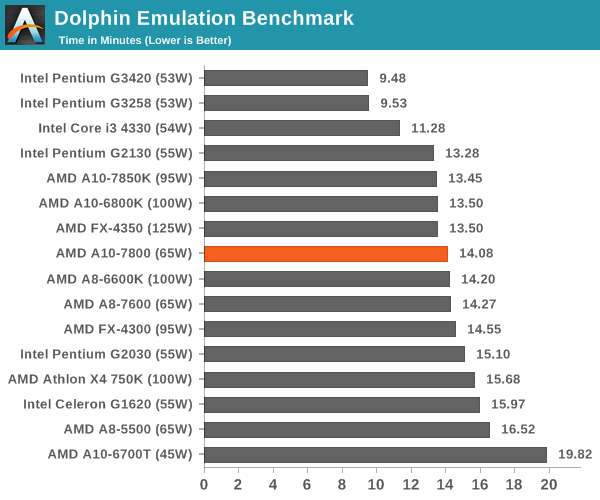
Dolphin seems to work best with high single core speed and Haswell.
WinRAR 5.0.1: link
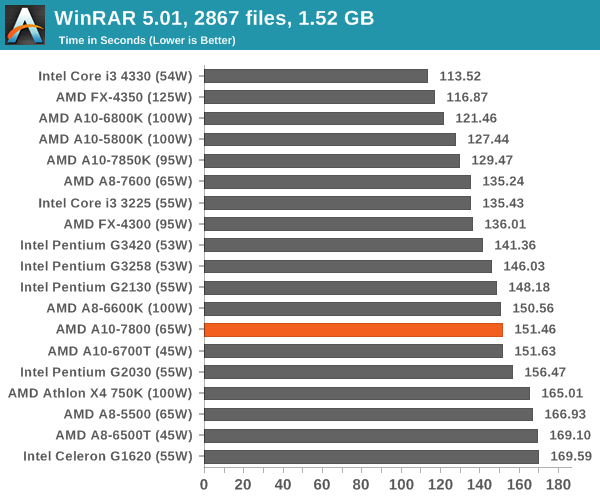
PCMark8 v2 OpenCL on IGP
A new addition to our CPU testing suite is PCMark8 v2, where we test the Work 2.0 and Creative 3.0 suites in OpenCL mode. As this test is new, we have not run it on many AMD systems yet and will do so as soon as we can.
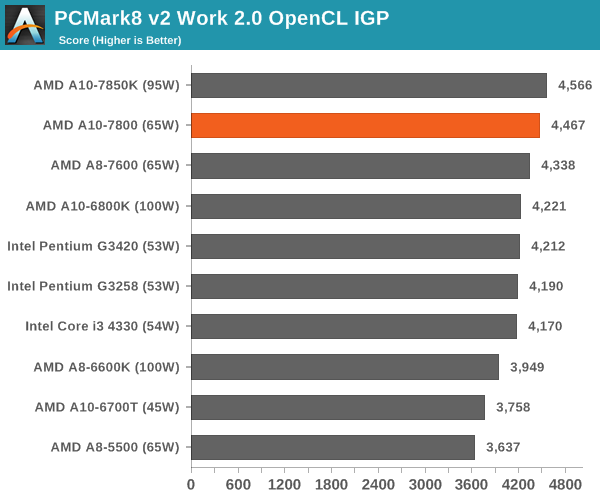
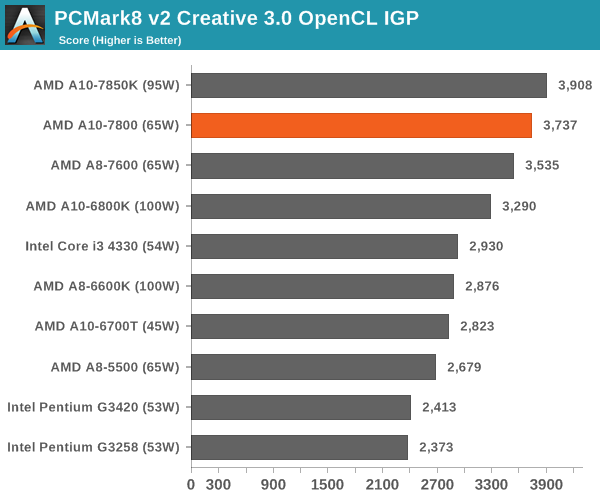
The combination of processor graphics and OpenCL support push the AMD APUs up to the top of our PCMark tests.
Hybrid x265
Hybrid is a new benchmark, where we take a 4K 1500 frame video and convert it into an x265 format without audio. Results are given in frames per second.
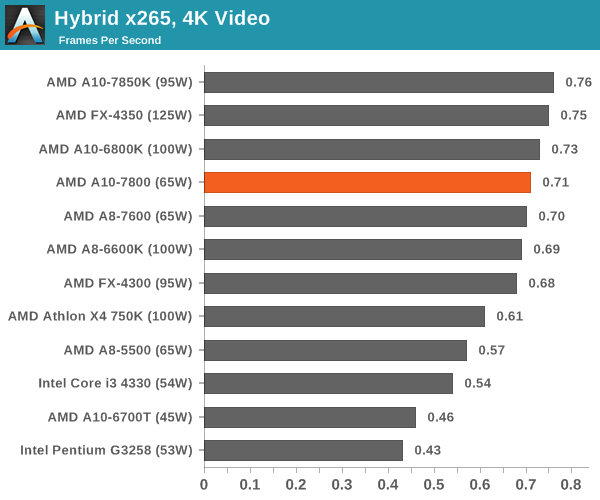
Cinebench R15


Cinebench is typically Intel territory for high IPC processors, but when it comes to multithreaded rendering, extra threads help.
3D Particle Movement
3DPM is a self-penned benchmark, taking basic 3D movement algorithms used in Brownian Motion simulations and testing them for speed. High floating point performance, MHz and IPC wins in the single thread version, whereas the multithread version has to handle the threads and loves more cores.
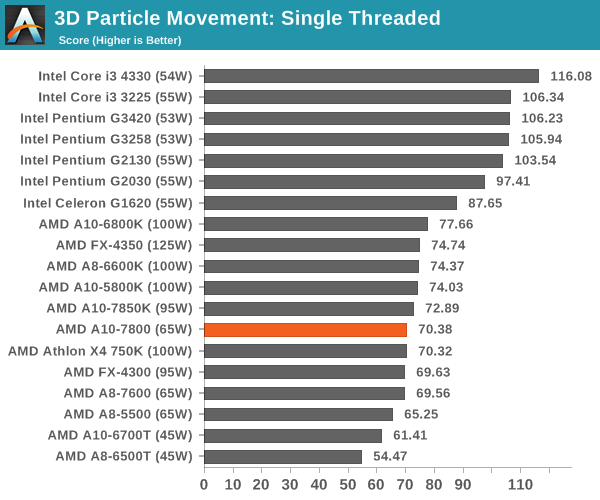
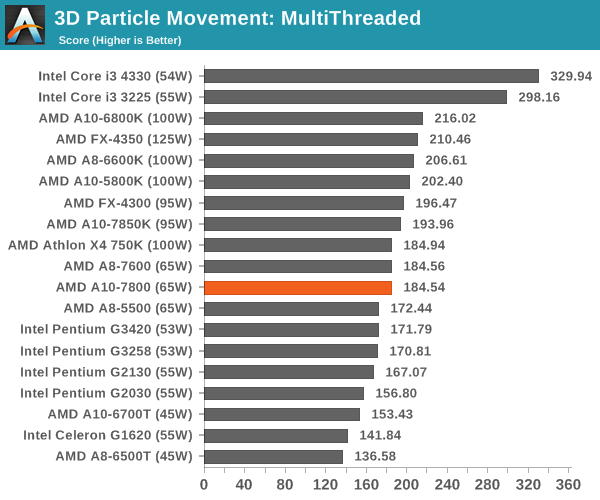
All the calculations in 3DPM deal with floating point numbers, a known sink for AMD compute.
FastStone Image Viewer 4.9
FastStone is the program I use to perform quick or bulk actions on images, such as resizing, adjusting for color and cropping. In our test we take a series of 170 images in various sizes and formats and convert them all into 640x480 .gif files, maintaining the aspect ratio. FastStone does not use multithreading for this test, and results are given in seconds.
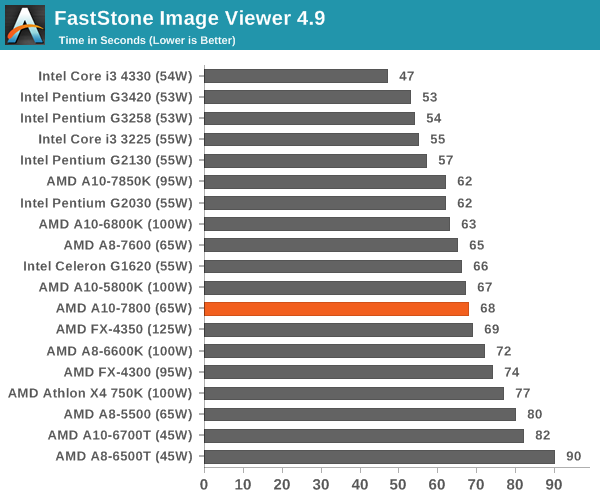
Web Benchmarks
On the lower end processors, general usability is a big factor of experience, especially as we move into the HTML5 era of web browsing. For our web benchmarks, we take four well known tests with Chrome 35 as a consistent browser.
Sunspider 1.0.2

Mozilla Kraken 1.1
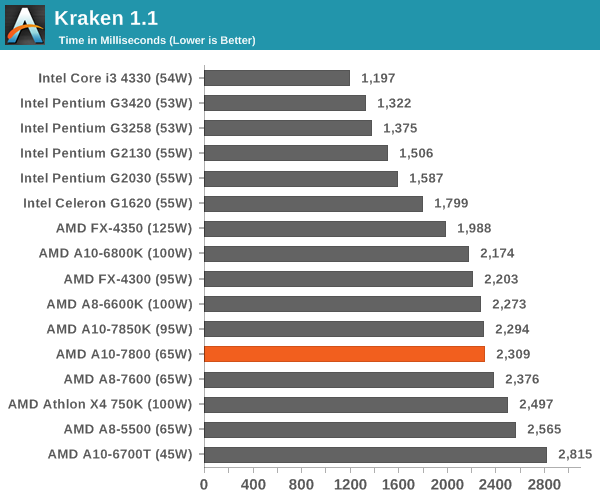
WebXPRT
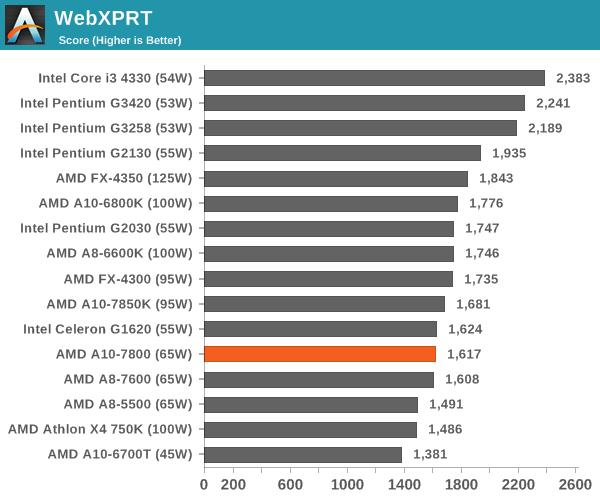
Google Octane v2
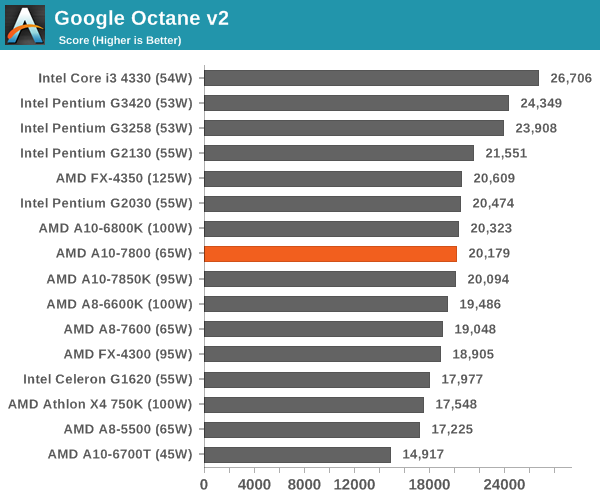










147 Comments
View All Comments
r3loaded - Thursday, July 31, 2014 - link
Conclusion: Unless you absolutely need fast, integrated graphics, a cheap Haswell will stick kick AMD's ass.Creig - Thursday, July 31, 2014 - link
What Haswell system will keep up with Kaveri at the same price point?Anonymous Blowhard - Thursday, July 31, 2014 - link
A10-7800 - $150FM2+ - $50 (maybe a Hudson D2 if you're lucky)
G3220 - $60
LGA1150 H87 mATX - $42
R7 260X - $100
Sorry, that won't "keep up" with Kaveri - it will WRECK it.
Flunk - Thursday, July 31, 2014 - link
You're right, blowhard. It would crush it, except in CPU multithreaded benchmarks... But who cares about that?The funniest thing about this build is that AMD products still soak up the majority of the budget.
silverblue - Thursday, July 31, 2014 - link
There are some instances that having a 2C/2T CPU will begin to make less and less sense as time goes on; for example, BF4 performance is reduced compared to the i3s and especially so compared to the i5s/i7s, but whilst this may become more and more common as time goes on with newer engines, there's still plenty of titles that a Pentium will shine in. However, will the frame latencies be acceptable? The following article does pose some interesting questions...http://www.eurogamer.net/articles/digitalfoundry-2...
FriendlyUser - Thursday, July 31, 2014 - link
I think you are right. The 4-core processors are way more future-proof. Single-thread performance has been very important but has also stagnated. Plus, we all know that the consoles are multi-core machines and game programmers will have to work with well-threaded engines.silverblue - Saturday, August 2, 2014 - link
It's one of those situations where the more threaded an engine becomes, the more Kaveri should outperform Piledriver due to not having the decoder switching between threads all the time. Piledriver's saving grace is clock speeds, but if AMD was to be able to release a Kaveri refresh, I'm sure they'd have mastered the 28nm process by then and be able to get a bit more speed out for the same power.Computer Bottleneck - Thursday, July 31, 2014 - link
I liked article a lot. The author makes a good point about cpu to gpu balance.Therefore, if frame time variance will be examined in the future with 2C/2T processors I would hope appropriately sized discrete cards would be used. Maybe R7 260X or smaller (at suitably low resolution and detail settings) is a good starting point for testing 2C/2T processors in the future?
kmmatney - Thursday, July 31, 2014 - link
If you lower the budget (take out the graphics card) you can get an A8 6600K + MB for $99.99 at Microcenter. For light gaming this will way outperform the Intel solution with IGP, anf be plenty good enough for all other uses.kmmatney - Thursday, July 31, 2014 - link
I'll admit - if you don't have a local Microcenter near you (I have one in Denver) then it's harder to go AMD.